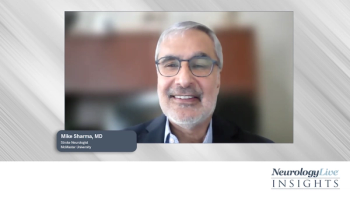
The Importance of Telehealth with Peter Rasmussen, MD
Digital medicine is used to increase access for rural and underserved areas, allowing for the delivery of patient care, patient monitoring and specialist consultations.
Peter Rasmussen, MD
In an interview with NeurologyLive Peter Rasmussen, MD, Medical Director of Digital Health, Cleveland Clinic, spoke about the role of telehealth, particularly in the field of neurology, as well as the barriers clinicians face.
Now as telemedicine is more commonly used, minimizing barriers to care, clinicians will be able to better maintain patient relationships, providing better care and generally improving quality of life. Aside from the culture change and different techniques, Rasmussen is a proponent of utilizing telehealth. Rasmussen noted that telehealth, or digital medicine, is extremely effective in follow-up in patients with movement disorders, epilepsy and headache, where detailed examinations on subsequent visits are not necessarily required.
NeurologyLive: What role does telehealth play in the field of neurology?
Peter Rasmussen, MD: I think it’s quite important and helpful in several areas and it depends upon where you are and where you’re practicing, and if you’re the patient of the provider. One of the areas where it’s most important is in telestroke evaluation of patients. It’s been used in that arena now for probably 15 years or so, or more, with its modern version probably 13—15 years, and that’s really highly effective—it’s about 98% to 99% as effective as having a stroke neurologist in person and that’s, of course, audio-visual interactions between a patient and the emergency room where they’re located, usually remote from a hospital. The other area that it can be very effective in is delivering in person in-patient teleneurology consultation.
The way we [Cleveland Clinic] use it generally is for patients who were admitted to the hospital not for primary neurologic reasons but who require neurology consultation as part of hospitalization for another reason—we offer that in several of our community hospitals. Telehealth can also be very effective in keeping patients closer to home and avoiding transfer or transport to another facility or delay in seeing a neurologist after discharge. Other things that telehealth or digital health can be helpful in the neurology patient is access to neurologic expertise and ease of eliminating geographical barriers. When patients are in the ambulatory environment, we use it for access for new patient access, for patients who have epilepsy, movement disorders and headache. Then, of course, it’s also very effective in follow up for all types of patients, postsurgical patients and also for follow up in patients with things like movement disorders, epilepsy and headache as well, where detailed examinations on subsequent visits aren’t necessarily required.
Are there any challenges about telehealth you've observed from the patient or provider side?
PR: From the patient side, they generally don’t have too many concerns about virtual visits or telehealth. Many times, they’re delighted to be able to see a neurologist remotely to eliminate the need for travel or staying at a hotel overnight or even air travel for that matter to give another opinion.
The barriers I’ve seen generally are from providers. Providers/neurologists frequently are concerned about their ability to examine the patient or their need to examine the patient. That’s not an enormous barrier, there are a lot of reasons to see a neurologist that don’t require a detailed neurological examination. In disorders like epilepsy, if patients have been seen by an epileptologist or neurologist beforehand and they’ve had an examination by an expert or a professional, you can just review that from a documentation standpoint, a lot of that is just history taking at that point in time and reviewing of images which can also be done remotely as well, the same thing is true for headache. Many times patients with headaches have seen their primary care doctor and have had a neurological exam there, perhaps even imaging, and again it’s really just history based to get people moving on the path of headache evaluation and/or treatment strategy for that.
Other barriers have been around payment, and that really depends upon where the patient resides and what the local rules, regulations and laws are in that state. Many states have many payment coverage and parity laws that require insurance companies to pay for telemedicine or virtual visits. Unfortunately, Ohio does not have payment parity. In that regard then, we do look at cash models or patients if they can avoid the travel frequently find it cost effective to pay cash for the virtual visit, or in some situations we will look at giving away that care for free or alternate reimbursement models particularly like telestroke where we’ll contract directly with the referring hospital and they would pay for the services as opposed to the patient or their insurance company.
Cost problems can be overcome frequently and the same is true for remote neurology inpatient evaluations. Many times, these will be rural hospitals that don’t have a high enough patient volume to require a neurologist in the community or there is only one neurologist in the community and that person might be going on vacation or have a very busy outpatient clinic and doesn’t have the time to commit to the inpatient service; so that can be supplemented there then the hospital covers the cost of that visit as opposed to having to bring in another neurologist to augment the community. Those are a variety of ways to work around the reimbursement end of things. A lot of it though really boils down to the ability to adapt to culture change and technology and new ways of doing things, a lot of people are just resistant to that change—that I have not found to be generational, that is really more personality type related than anything else. One of our most prolific teleneurologists was 82 years old when he left practice and he was doing a half day of teleneurology in his practice. He had a wonderful curiosity for technology and was very keen on helping patients and he was also able to project himself in the community as where a neurologist otherwise wouldn’t be—I found that highlight gratifying.
Those are some of the main barriers around telehealth. As a professional in these interactions, if you deem that it’s really required that the patient needs a detailed examination or additional care then you simply refer the patient to an in-person facility or see the patient in your office, but clinicians don’t have to end the interaction with a virtual or telemedicine visit.
In my view, I’m obviously a proponent, and I don’t find too many barriers that are realistic other than the culture change and different ways of doing things.
Transcript edited for clarity.
Newsletter
Keep your finger on the pulse of neurology—subscribe to NeurologyLive for expert interviews, new data, and breakthrough treatment updates.


































